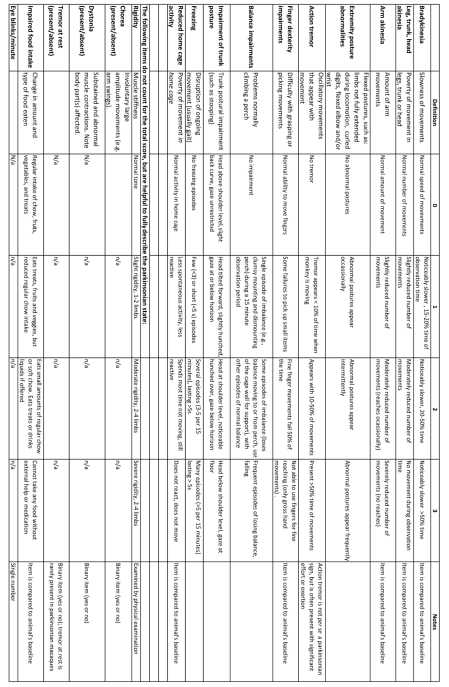Rating scale for parkinsonian motor signs in macaques and other non‐human primates
Thomas Wichmann, Adriana Galvan
Disclaimer
The protocols.io team notes that research involving animals and humans must be conducted according to internationally-accepted standards and should always have prior approval from an Institutional Ethics Committee or Board.
Abstract
This protocol details rating scale for parkinsonian motor signs in macaques and other non‐human primates.
Attachments
Steps
Description of rating scale
Parkinsonian motor signs in macaques closely resemble findings in humans. To quantify the degree of parkinsonism in our animals, we use the rating scale reproduced on the next two pages. There are a variety of such scales available, each differing slightly by areas of emphasis.1‐3
The scale emphasizes akinesia, bradykinesia and gait instability.
- The definition of the individual scale components is provided in appendix 1, and a sample scoring sheets (for 4 observations) is provided in appendix 2.
- The quantification of the chosen parkinsonian signs can be done based on observation only and can be applied to archival footage (such as video segments). Many of these items can be rated separately for either side (to generate scores for the right (R) or left (L) sides).
Appendix 1: Description of individual score criteria

Appendix 2: Example scoring sheet (4 days)

Other parkinsonian signs, such as tremor at rest, are inconstant (or not existent) in most non‐human primates.
- Rigidity, another cardinal sign of parkinsonism, is present in many animals, but, because it can only be tested by examination or instrumented studies (torque motor responses), was not included in the main list of items of our scale.
- These items, in addition to others such as chorea or dystonia, are included in a secondary list, used for documentation purposes only.
The 10 primary items of the scale each contribute maximally 3 points (adding up to 30 points total, with overall scores being used for items that are rated separately for the right and left side).
- We use the summary score to classify animals into those which are mildly parkinsonian (5‐10/30 points), moderately parkinsonian (10‐20/30 points), and severely parkinsonian (> 20 points).
Use of scale
It is a challenge to obtain a high‐quality record of the animal’s spontaneous behavior, as observations in a specialized cage or direct observations by an observer tend to influence the animal’s behavior. We therefore typically use the scale to observe animals in their home cages, either in person or (more commonly) on video tape.
To obtain reliable scores with low variance, the external conditions under which the animal’s behavior is examined should remain constant.
- Among these are the time of day of the observation, the cage position and proximity to other animals in the animal housing area, the lighting, the presence (or absence) of food items, and the presence or absence of auditory or other stimuli that may distract the animals or otherwise interfere with behavior.
Prior to the induction of parkinsonism, the animal should undergo at least 5 baseline observations against which the subsequent behavioral observations can be judged. 10‐20 minutes of observation times will provide adequate sampling of behaviors.

